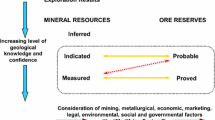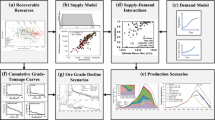Abstract
Aggregates are produced from sand and gravel deposits or from bedrock sources. Production sites are numerous to minimize transport and are more and more in a competing land use position. Urbanization, while creating a market, also sterilizes deposits and pressures producers to relocate further from populated areas. Regulating and permitting quarries is an issue in regions with growing populations. This regulatory environment may cause exploitation schemes to evolve towards greater recycling, importing, and marine production, for example. These changes may be entirely attributable to increased environmental constraints on producing operations and not on conventional mining constraints such as overburden, ore grade, and costs of operation.
Similar content being viewed by others
References
ADI Ltd. (1986) Study of markets for aggregate materials accessible from Nova Scotia and New Brunswick. Open file report 86-9, New Brunswick
Beeby DJ (1988) Aggregate resources, California effort under SMARA to ensure their continued availability. Min Eng 40(1):42–45
Belsky E (1992) Factors affecting economic risk in mining: Focus on pollution insurance and bonding. In: Van Zyl D, Koral M, and Li TM (eds), Risk assessment/management issues in the environmental planning of mines. Littleton, CO: AIME pp 143–148
Brockie L (1991) Public participation: Increased demands in the 1990's. Fort McMurray: CIM District Five Meeting. Paper 21
Bronitsky L (1973) The economics of construction mineral aggregate. PhD thesis. Troy, N.Y.: Rensselaer Polytechnic Institute. 333 pp
Carter PD (1981) The Economics of mineral aggregate production and consumption in Newfoundland and Labrador. Newfoundland Department of Mines and Energy Report. 112 pp
Carter WL (1975) The paradox of quarrying in the northeastern megapolis. Environ Geol 1(2): 67–68
Collis L and Fox RA (Eds) (1985) Aggregates: Sand, gravel and crushed rock aggregates for construction purposes. Engineering Geology special publication No. 1. 220 pp
Consedine RL (Ed) (1992) Newfoundland coastal quarry makes record shipment to New York city. Can Aggregate 6(1):4 pp
Dunn JR, Cueman ER, and Preston CM (1980) Zoning for minerals in Carroll County, Maryland: Proceedings of the fourteenth annual forum on the geology of industrial minerals. NY State Mus Bull 436:3–5
Edwards WAD (1989) Current and future demand for aggregate in the Edmonton region. CIM Bull 82(923):118–123
EPA (1976) Economic impact of effluent guidelines: Mineral mining and processing industry. Environmental Protection Agency, Office of Water Programs. 230/2.74-059a. 328 pp Washington, D.C.
Freyfogle ET (1988) Granite rock: Institutional competence and the state role in federal land planning. Univ Colo Law Rev 59:475–516
Frondistou-Yannas S (1981) Economics of concrete recycling in the U.S. In: Kreijger PC (Ed), Adhesion problems in the recycling of concrete. NATO conference series IV, New York: Plenum Press. 163–186 pp
Giuliani SE and Siotto G (1992) Study of environmental impact of marble quarries and stone working facilities in Sardania. In: Singhal RK, Mehrotra AK, Fytas K, and Collins J (Eds). Proceedings of environmental issues and management of waste in energy and mineral production. Rotterdam: Balkema pp 227–236
Guillet RG (1980) Constraint of industrial minerals—the Ontario experience: Proceedings of the fourteenth annual forum on the geology of industrial minerals. NY State Mus Bull 436:21–26
Hale PB (1990) Mineral resources. In: Geology of the continental margin of eastern Canada. Keen MJ, and Williams GL (Eds). Geological Survey of Canada. pp 721–741 Ottawa, ON
Hansen TC (1986) Recycled aggregates and recycled aggregate concrete, second state-of-the-art report developments 1945–1985. Mater Struct 111:201–246
Hayes VL (1990) Moving stone: An overview. Rock Prod 93(9):16–21
Hillmann FR (1991) Recycling rubble: Does it have to be a “no win” business proposition? Can Aggregates 5(1):24–25
Huhta RS (1988) Buyouts in the aggregate industry, comments. Rock Prod 91(3): 15
Ladoo RB (1964) Economics of the mineral industries. In: Robie EH (Ed). Marketing of industrial minerals. New York: AIME
Langer WH (1988) Natural aggregates of the conterminous US, US Geological Survey Bulletin. 33 pp
Langland L (1987) Locating, sampling and evaluating potential aggregate deposits. In: Peirce HW (Ed). Proceedings of the 21st forum on the geology of industrial minerals. Arizona Bureau of Geology and Mineral Technology Special Paper 4
Leet LD, Judson S, and Kauffman ME (1978) Physical geology. 5th ed. U.S.A. Englewood Cliffs, NJ: Prentice-Hall
Lehmann D (1991) Using recycled asphalt pavement as an aggregate. Can Aggregates 5(1): 22
McDonald GT (1989) Rural land use planning decision by bargaining. J Rural Stud 5(4):325–335
Meyer DA and Zelnak SP Jr (1991) Structure and Economics. In: Barksdale RD (Ed). The aggregate handbook. Washington DC: National Stone Association, pp 2.1–2.17
Miller CK and Fowler JH (1987) Development potential for offshore placer and aggregate resources of Nova Scotia, Canada. Mar Min (USA) 6(2):121–139
Miller RH and Collins RJ (1976) Waste materials as potential replacement for highway aggregates. National Cooperative Highway Research Program Report 166. 94 pp
Narumi Y (1989) Offshore mining in Japan. Rock Products 92(1): 64–68
Ontario Ministry of Natural Resources (1992) Mineral aggregates conservation, reuse and recycling. John Emery Geotechnical Engineering Limited. Prepared for the Ontario Ministry of Natural Resources
Patty EJ and Wongsosentono S (1987) Land use, environment and construction materials. In: Arndt P, and Lütting GW (Eds). Mineral resource's extraction, environmental protection and land-use planning in the industrial and developing countries. Stuttgart: E.Schweizerbart'sche Verlagsbuchaudlung pp 303–311
Pennington D (1980) Minimizing regulatory problems of non coal surface mines: Proceedings of the 14th Annual Forum on the geology of industrial minerals. NY State Mus Bull 436:6–12
Philipson G (1989) Deep quarrying: A cost study. Rock Prod 92(2):134–149
Poulin R, Loulou R, and Chauny F (1991) Mineral aggregate transport simulation. In: Poulin R, Pakalnis RC, and Mular AL (eds). Proceedings of the 2nd Canadian conference on computer applications in the mining industry. Vancouver: University of British Columbia and Canadian Institute of Mining and Metallurgy. pp 181–190
Preston J, Straus E, and Friz TO (1974) Model mineral reservation and mine zoning ordinance. Wisconsin Geological and National History Survey Information Circular 24
Pugliese JM, Swanson DE, and Engelmann WH (1978) Quarrying near urban areas: An aid to premine planning. US Bureau of Mines. IC 8804
Rukavina M (1987) Houston receives Scottish granite. Rock Prod 90(3):52–57
Rukavina M (1991) Vulcan opens Mexican quarry. Rock Prod 94(6):52–57
Sheridan MJ (1967) Urbanization and its impact on mineral aggregates industry in the Denver, Colorado, area. US Bureau of Mines. IC 8320
Smith LJ (1991) The marketplace. In: Barksdale RD (Ed). The aggregate handbook. Washington DC: National Stone Association pp 9.1–9.40
Stearn EW (1980) Study reveals rapidly dwindling resources availability. Rock Prod 83(8):60–61
Stigler G (1958) The economics of scale. J Law Econ 1: 54–71
Tepordei VV (1985) Crushed stone. Mineral facts and problem. US Bureau of Mines Bulletin 675
Tepordei VV (1989) Perspectives on sand and stone. Rock Prod 92(1):38–44
Thomson RD (1980) Mining of mineral aggregates in urban areas. PhD thesis. Pittsburgh: University of Pittsburgh. 171 pp
Turley W (1992) Aggregate producers fund local government's study. Rock Prod 95(7): 23–26
USBM (United States Bureau of Mines) (1987) An economic reconnaissance of selected sand and gravel deposits in the US exclusive economic zone. US Bureau of Mines. OFR 3-87
Warhurst A (1991) Environmental management in mining and mineral processing in developing countries: Enterprise behaviour and national policies. Brighton: Science Policy Research Unit, University of Sussex
West RG (1977) Pleistocene geology and biology, 2nd ed. London: Longman
Zdunczyk M (1991) Aggregate imports: Is it achievable? Min Eng 43(1):145
Zimmerman K (1991) Riding the recycling wave. Rock Prod 94(10):50–56
Author information
Authors and Affiliations
Rights and permissions
About this article
Cite this article
Poulin, R., Pakalnis, R.C. & Sinding, K. Aggregate resources: Production and environmental constraints. Geo 23, 221–227 (1994). https://doi.org/10.1007/BF00771792
Received:
Accepted:
Issue Date:
DOI: https://doi.org/10.1007/BF00771792




